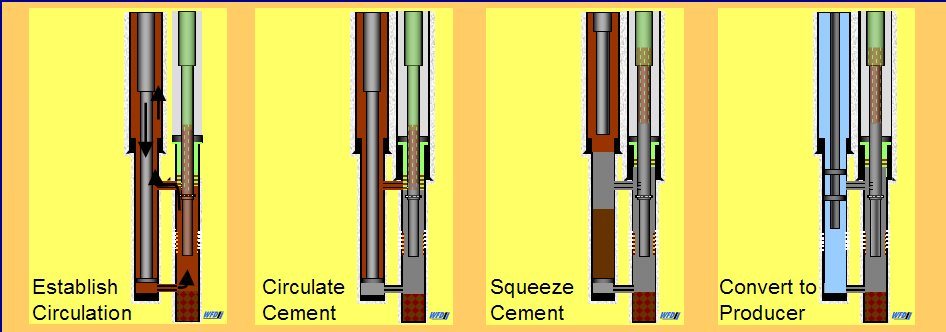|
Southeast Asia 2002

|
Problem:
While
development drilling well control was lost and gas broached to the seabed
under the platform. The well subsequently bridged and the broach stopped. It
was later discovered that the tubing and all protective strings of casing in
a well adjacent to the blowout were severed below the conductor and open to
the sea. This left an unacceptable single well control barrier, a TRSSV in
the tubing and a packer in the 9-5/8” casing, to protect the platform from
another subsea broach.
|
| Remedial Strategy:
The
basic design strategy was to drill an intervention well from an adjacent
bridge-connected platform and intersect the problem well at its production
casing string both above and below the producing reservoir. After
intersection was confirmed using electromagnetic homing-in technology, the
wells would be perforated and cement circulated down the relief well
drillstring, through a cement retainer, up the problem well’s production
casing and back into the relief well’s annulus. As a final assurance, a
balanced cement plug would be set across the upper perforations and squeezed
into the problems well’s tubing. |
| Special Services:
John
Wright Company (JWCO) was contracted to supervise the special services for
the relief well to include: pre-planning, on-site supervision, directional
drilling, surveying, casing detection, intersection and kill hydraulics.
Well Flow Dynamics provided hydraulic modeling, Vector Magnetics provided
electromagnetic ranging services and SDI provided gyro surveys and gyro MWD.
All companies worked together with JWCO to create a single special services
team. |
Challenges: The project
was complicated by the following:
- The platform was
considered a worldwide critical asset by the owner and all operations were
designed with significant safety factors to protect the asset.
- Multiple contingency plans
were required for each operation.
- The problem well was a
directional well at 47° inclination with uncertain surveys. Subsequent to
the first intersection, the plan called for steering the relief well 400m
at 4m proximity to the problem well with significant magnetic
interference.
- Dual intersection
techniques required low incidence angles and exceptionally precise
directional control.
- A relief well of this type
had never been attempted before.
|
Results:
- The project was completed according to
plan without significant problems or delays.
- The special services team was integrated
seamlessly with the drilling team to create an effective and efficient
operation.
- The dual intersection was executed
without significant delays.
- Hydraulic communication was established
with oriented TCP guns at the upper and lower intersections.
- Cement was circulated from the relief well
into the casing and across the reservoir section of the problem well and
back into the relief well. Cement was squeezed into the upper
intersection.
- The relief well was converted into a
producing well.
|

